#invented codex
Text
i wonder if tolkien's elves have a cantillation system for the silmarillion in-universe
#would be fun to do a full translation and invent one#and then make a physical handmade codex and write it all in tengwar plus the cant marks
36 notes
·
View notes
Text
Troy fell around 1200 BCE. Writing didn’t catch on broadly with the Greeks until Homer’s time, around 800 BCE.
Given that Achilles is fully literate in Hades game, he must have been standing in that hallway for around 400 years.
Patroclus is honestly holding it together better than expected.
#the thing that actually calmed Achilles legendary temper was literacy#hades game#although#phoenicians invented writing around 1000 bce#so it's possible he was only in that hallway for 200 years#still#I think we can agree that Pat is doing better than expected#other possibilities#Hades also rules over the Chinese underworld and so Achilles' codex is actually written in ancient chinese#so the first thing he did upon dying was learn some chinese I guess#yall the amount of research i ended up doing to write this post because of all theconflicting info on when writing hit greece#some historians have made up some shit
119 notes
·
View notes
Text
Leonardo da Vinci
Italian Renaissance architect, musician, inventor, engineer, sculptor, and painter Leonardo da Vinci, died at Amboise, in France on 2 May 1519.
His drawings and writings are collected in the twelve volumes of the Codex Atlanticus (Atlantic Codex) whose name indicates the large format of an atlas of the dimension 650×440 mm and the atlas-like breadth of da Vinci’s work. These 1,119 sheets dating…

View On WordPress
#Codex#flight#ideas#invention#left hander#Leonardo da Vinci#Milan#painting#people#perception#poetry#reverse#writing
1 note
·
View note
Text
Top 50 discos favoritos del 2023: 30 - 21
Tercera parte de la lista.
30.- Full of Hell & Nothing - When No Birds Sang
Atmospheric Sludge Metal, Shoegaze, Post-Metal
Dream Pop, Post-Rock

youtube
29.- Steven Wilson - The Harmony Codex
Art Rock, Electronic
Progressive Electronic, Progressive Rock, Ambient, Art Pop, Post-Industrial, Glitch Pop

youtube
28.- TWICE - Ready to Be
K-Pop, Dance-Pop
Nu-Disco, Pop Rock

youtube
27.- XG - NEW DNA
Dance-Pop, Pop Rap, K-Pop
Trap, Contemporary R&B, Hip House, Future Bass

youtube
26.- Dreamwell - In My Saddest Dreams, I Am Beside You
Screamo, Post-Hardcore
Metalcore, Post-Rock, Post-Metal, Blackgaze

youtube
25.- Invent Animate - Heavener
Djent, Metalcore
Post-Hardcore, Alternative Metal

youtube
24.- Young Fathers - Heavy Heavy
Neo-Psychedelia, Art Pop
Gospel, Spirituals, Post-Industrial, West African Music

youtube
23.- Yves Tumor - Praise a Lord Who Chews but Which Does Not Consume; (Or Simply, Hot Between Worlds)
Neo-Psychedelia, Post-Punk
Art Rock, Noise Pop, Post-Punk Revival, Dance-Punk, Glam Rock

youtube
22.- Jeff Rosenstock - HELLMODE
Indie Rock, Power Pop, Pop Punk
Singer-Songwriter, Skate Punk

youtube
21.- Wednesday - Rat Saw God
Indie Rock, Noise Rock, Alt-Country
Slacker Rock, Noise Pop, Shoegaze, Alt-Country

#Youtube#Full of Hell & Nothing#When No Birds Sang#Steven Wilson#The Harmony Codex#TWICE#Ready to Be#XG#NEW DNA#Dreamwell#In My Saddest Dreams#I Am Beside You#Invent Animate#Heavener#Young Fathers#Heavy Heavy#Yves Tumor#Jeff Rosenstock#HELLMODE#Wednesday#Rat Saw God#2023#music#best albums of 2023
0 notes
Text
reading on reading
a literary syllabus [x]

how to read now by elaine castillo
a collection of essays by novelist and essayist elaine castillo about the politics and ethics of reading. castillo exposes the inherently colonial premises behind not only the works of many individual writers; but the way reading cultures analyze and canonize works, the tokenizing nature of the publishing industry that fails writers and readers of color, and the unfulfilled promises by bibliophiles and literary institutions to "build empathy" through reading diverse books.
"time in the codex" and "lastingness" by lisa robertson
two essays by poet lisa robertson from her prose collection nilling, both meditations on reading. “time in the codex” is an ode to the sensory and cognitive processes that reading evokes. “lastingness” explores the relationship between passivity and will when it comes to receiving the stories and ideas we read, using the work of hannah arendt to analyze texts by lucretius and pauline réage.
a history of reading by alberto manguel
alberto manguel (former director of argentina's national library) compiles a history of reading that encompasses the prehistory of books in ancient mesopotamia, the story of the library of alexandria and its influence in libraries that followed, literary societies such as the heian court, book thieves throughout time, book banning in multiple cultures, and the progression of text formats around the world from clay tablets to modern bookbinding.
selections from not to read by alejandro zambra (trans. megan mcdowell)
essays taken from the collection not to read by chilean writer alejandro zambra about the practice of reading, his own evolving reading life, and writing books; mixed with a variety of literary criticism. selections include "in praise of the photocopy," "against poets," "obligatory readings," "traveling with books," and "novels-- forget it."
"how do we read?", "the reading ape", and "inventing reading" by stanislas dahaene
three chapters from cognitive neuroscientist stainslas dahaene's book reading in the brain. "how do we read?" functionally breaks down how our brain understands written words. "the reading ape" imagines how our ability to read evolved by recycling preexisting neural circuits. "inventing reading" explores how languages themselves have formed over time to serve the way we think.
"when robots read books" by inderjeet mani
essay by computational linguist inderjeet mani on ways that artificial intelligence could enhance literary criticism by analyzing classic texts, particularly cumulative corpuses of works. examples of literary AI usage include finding similar character traits, archetypes, and tropes between different books and authors; quantitatively tracking literary trends; and generating timelines and maps of information pulled from narratives.
"uncritical reading" by michael warner
essay by english professor michael warner which attempts to define what "critical reading" actually is, the beginnings of a history of that practice, its alignment with agency and morality in academic culture, and what the qualities of "uncritical reading" (such as “identification, self-forgetfulness, reverie, sentimentality, enthusiasm, literalism, aversion, distraction") might offer us.
"someone reading a book is a sign of order in the world" by mary ruefle
essay adapted from a lecture in poet mary ruefle’s madness, rack, and honey that traces a reader's development through personal experiences in her own reading life. topics include rereading, what it means to read “the right book at the right time”, and the pleasure of finding imaginative connections between books.
3K notes
·
View notes
Note
In regards to the really strange astronomical codex, I know in later eras that depicting black people like that (as in, making their skin actually black instead of a natural brown skin tone) was done for racist reasons. Was there a different reason for doing it in that codex/during that time period or was it still just racism? Or possibly a combination of the two?
i'm really not qualified to answer that. i don't even know why there are so many black people in this codex (this ask is about this post) in the first place. i'm wondering the same thing about this other astrological manuscript i've come across (a copy of "de figura seu imagine mundi" by ludovicus de angulo, lyon, c. 1456):
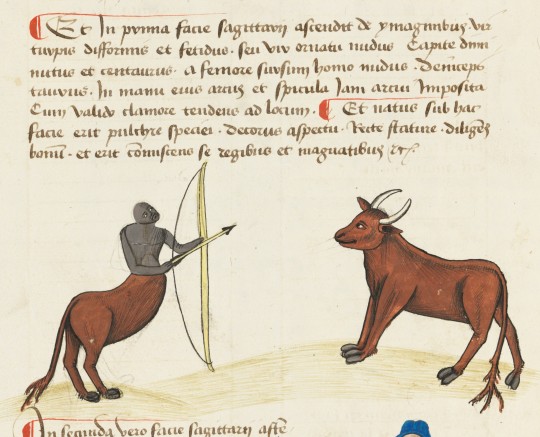
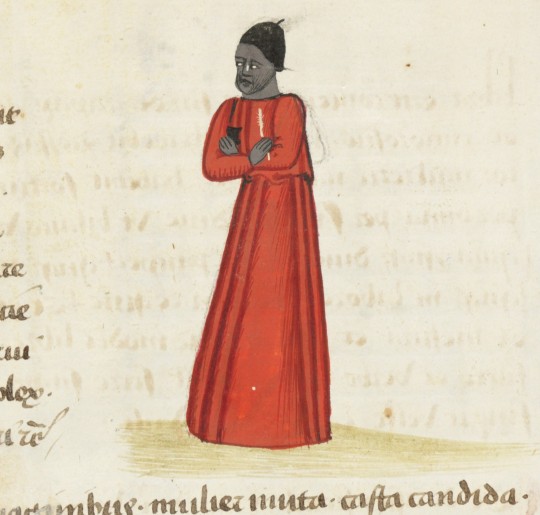

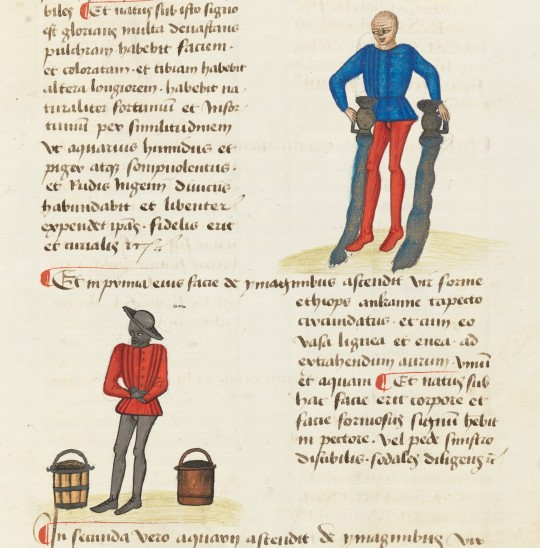
source: St. Gallen, Kantonsbibl., VadSlg Ms. 427, fol. 88v-92r
all i know here is that these are all illustrations for the decans of different zodiac signs, but i don't know why some of the figures are depicted as poc. but again, i'm no expert at all.
if you're interested in medieval race studies, i've been told that both of these books are really good resources (i haven't read them myself yet): “the invention of race in the european middle ages” by geraldine heng, and “black metaphors: how modern racism emerged from medieval race-thinking” by cord j. whitaker
58 notes
·
View notes
Text
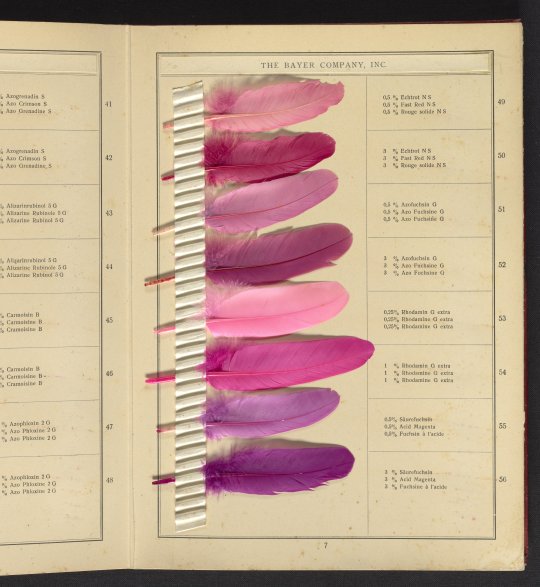
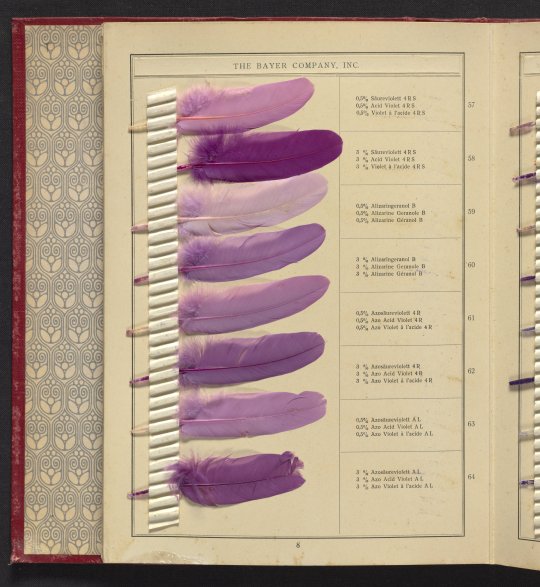
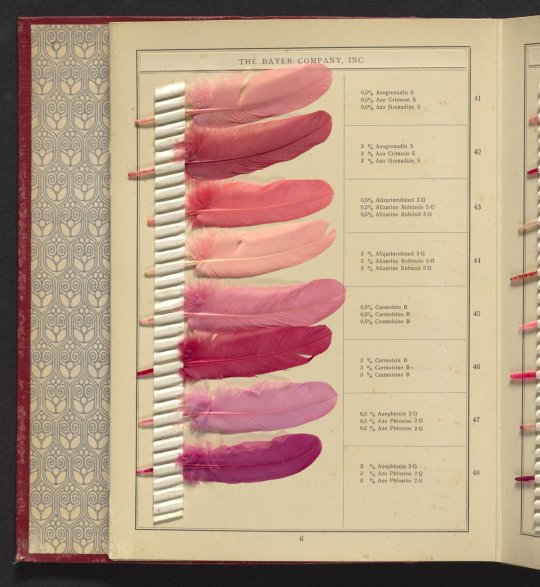
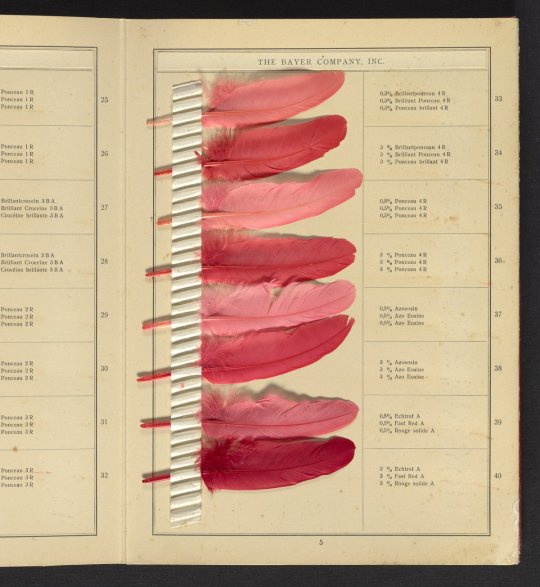

Ausfärbungen auf Federn / Teintures sur Plumes or Shades on Feathers is a sample book from 1915 with dyeing instructions and an 18-section foldout containing 143 dyed feathers. Published by the Bayer Company of New York City in English, French
and German, the book begins with instructions for dying feathers (clean them in soap and ammonia, then boil in salts and sulphuric acid).
Humanity has been colouring things for millennia. Scientists have found evidence of the first natural reds and oranges in tombs back to 2600BC.
Written in Greek, the Papyrus Graecus Holmiensis (also known as the Stockholm papyrus) is a 4th century CE codex of craft recipes compiled in Egypt. The work’s 15 leaves contain 154 recipes for the manufacture of dyes and colours used in fashioning artificial stones.
Recipe 101 is as follows:
“Cold Dyeing for Purple which is Done in the True Way”
“Keep this as a secret matter because the purple has an extremely luster. Take scrum of woad from the dyer, and a sufficient portion of foreign askant of about the same weight as the scum – the scum is very light – and triturate it in the mortar. Thus dissolve the alkanet by grinding in the scum and it will give off its essence. Then take the brilliant color prepared by the dyer – if from kermis it is better, or else from kirmnos – heat, and put this liquor into half of the scum in the mortar. Then put the wool in and color it unmordanted and you will find it beyond all description.”
Back then, purple was the marker of rank and class.
The most well-known shellfish dye was the Tyrian purple, royal purple or imperial purple as it was called, which came from sea snails in the Eastern Mediterranean in the ancient city of Tyre. This dye was very special for all the civilisations around the Mediterranean and its use spanned whole centuries. It was the most expensive dye in the whole of ancient world, as the colour it produced was very bright and colourfast. Because of its properties, its use was restricted for royals, members of the royal family, and senior public officers and priests.
Archaeological evidence points out that the ancient Phoenicians first discovered and used it (Tyre was an important Phoenician city). From them, it became known to ancient Greeks, Romans and through them in Byzantium and Medieval Europe. It was so sought after that the Byzantine emperor Theodosius I prohibited its use from the lower classes or the penalty was death. The privilege of using this purple dye is so profound that the phrase “born in purple” was born in that period. In Western Europe, it was replaced in prominence around the 12th century, and finally went out of fashion around the 19th century, when a synthetic purple was invented and thus it became more accessible to the wider masses.
https://flashbak.com/shades-of-feathers-a-beautiful.../
101 notes
·
View notes
Note
I love your OC's design
Please infodump about them

Their name is Nanno Metamorphose. They’re a 19 year old changeling engineer/inventor whose work motto is pretty much “fuck around and find out”. A lot of trial and error. Due to their impulsive and reckless nature they tend to not heed warnings or read instructions. Whatever works, works. What doesn’t? Welp, now we know.
The trademark for their work is how they utilize magic items in their machinery (magic crystals, plants, etc). The idea that science and magic can’t coexist is stupid to them. Their favorite invention is their big robo-gecko buddy Codex.
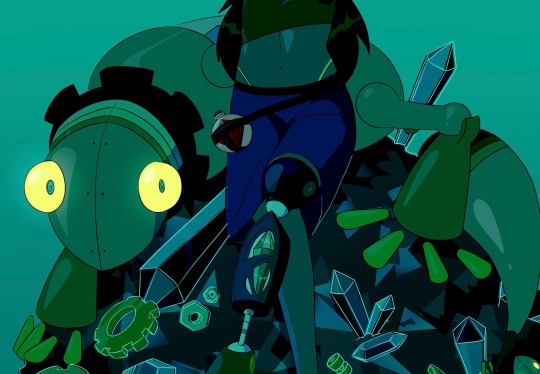
^ Codex doubles as both a companion and a weapon.
Nanno is a college reject who secretly lives in Zana’s dorm and tinkers away all day. When they’re not in the dorm they’re either defacing Zana’s college campus with graffiti, or listening in on student drama. They like to transform into students and make the drama worse for funsies.
Nanno speaks with a lot of slang and likes to playfully tease people. The voice I’ve always had in mind for them is Anna Akana’s. Characters their design is inspired by are Donnie from ROTMNT, Jinx from Arcane, Sasha from Amphibia, and Peridot from SU
Codex is inspired by Vah Rudania from BOTW
#For the record#I’ve never seen ROTMNT#I just got flooded with Donnie clips on Tiktok on accident#But YEAH that’s the general lowdown on Nanno#honeybee rambles#wonderhell
135 notes
·
View notes
Text
To this day I still see people say stuff like Tyranids can't or shouldn't win major fights, and it still annoys me. Their "reasoning" is always so stupid. Like it's called creative writing, just because you personally can't imagine a good story where Tyranids win the war, doesn't mean it's impossible, you just lack the creativity.
You see it with other factions as well, but I hear it most often with Tyranids.
"BuT iF tHeY wIn ThE sEtTiNg Is OvEr"
As if multiple individual planets or star systems haven't fallen already and the Imperium still stands. You don't have to destroy Macragge itself. New planets are invented all the time, with skill and effort you can make the audience care about them before destroying them.
"BuT iF tHe TyRaNiDs WiN, ThErE wIlL bE nO sUrViVoRs tO tElL tHe StOrY"
Firstly 40k is fiction. It's not history. 'History is written by the victor' doesn't apply here. You can have the POV character die at the end of the story. Secondly, they can escape on a spaceship. Or escape through the Webway. Tyranids can devour a planet and there can still be survivors.
"BuT nO oNe WaNtS tO rEaD aBoUt ThE pRoTaG lOsInG"
There is literally an entire genre called tragedy that has existed for thousands of years. You can also have the Tyranids win the war for the planet, but the protagonist win their own personal objective. Escaping, recovering an artefact, rescuing a person, earning glory/fame, learning information, the list goes on.
It's just, ugh. So many ridiculous arguments from people who don't understand or don't even like Tyranids, haven't read the codexes, and are allergic to any creative problem solving. -_-
262 notes
·
View notes
Text
A Survey of Available Lore on Baalphegor, Princess of Hell
Summoned from the Candlekeep libraries by @sky-kiss, from her ask here.

I burst through the door, scrolls tumbling everywhere. A bat flies out of my cloak and up to the rafters. Welcome to my TedxTalk wait where are you going-
Okay so. My pet topic du jour: Baalphegor. You’ll find tinfoil hats taped underneath your seats; please save those for the end of the presentation.
Sky is very much correct that the last information we have for Baalphegor is that she is “missing”, with no more real information than that. We have no information on the timeframe of her disappearance relative to Raphael’s own residence on Cania, so there’s a lot of room for extrapolation.
I have compiled what is, as far as I am aware at least, every notable reference to Baalphegor. Note: if you have knowledge of any others that I’ve missed, please tell me.
Most of the primary and/or more modern (as in, printed in the 21st century) sourcebooks just refer to Baalphegor in passing, as seen in the entire sum of her appearance in the Fiendish Codex II (my beloved):
Meanwhile, his new courtiers, selected for their ability to deliver innovative applications of his hellfire techniques, work to solidify their positions. Foremost among this group are Baalphegor (Mephistopheles’s consort) and the pit fiend Buldumech.¹
We have to go way back to get anything of interest for her, back to the 1980s, and the Dragon and Dungeon magazines. These were the two official magazines published for players of Dungeons & Dragons, filling a role similar to that of modules in the present day version of the game.
Baalphegor is referenced first in Dragon issue #76, published in 1983. We actually find a lot of detail about her here, the most pertinent of which is:
Baalphegor is consort to Mephistopheles, and a most highly regarded she-devil. Personally attractive (and a practiced diplomat), she is charming in manner and artful in thought; she has invented many of the strategies and devices used in the hells. Asmodeus regards her as one of his most valuable assets, and tolerates the machinations of Mephistopheles largely because of her. Baalphegor’s own desires are seldom revealed; she appears loyal to the hells and devoted to Mephistopheles, and manages to avoid making a distinction between the two.²
This tells us that not only is she clever and diplomatic, but also staggeringly intelligent. Mephistopheles spends a great deal of his focus on research and development of new spells and magical items - for Baalphegor to be the source of “many of the strategies and devices used in the hells” says a great deal about her intellect.
As well, the regard Asmodeus holds her in is wildly unusual for any devils, let alone the Lord of the Ninth. True loyalty among devils is largely regarded as a character flaw, and never to be trusted.
Dragon #76 goes on to describe her physical appearance (or one of them, at least):
Baalphegor is a musical-voiced, beautiful female, apparently human, save for her ruby-red eyes, forked tail, and slim, delicate leathery wings. Her feet are human in appearance, and she is sleek and curvaceous, with cinnamon-brown skin. She appears young and carefree, but when angered her light voice can crack like a whip, and her eyes flash fire.²
Baalphegor appears again in a module in Dungeon issue #2, published in 1986. In this adventure she is, unknown to the player characters, their true antagonist, controlling events and planning her machinations from the shadows, a true devil to her core.
In the module, she appears as a child, named Belle Fagor, keeping tabs on the members of a devil-summoning coven. (It is important to note that she is not the devil they summoned, but a lesser one.) Her stated motivation for this ruse is:
Desiring a break from the infernal politics of the Nine Hells, Baalphegor is enjoying herself and regards her interplanar tinkering as a sort of game, with its own rules.³
She’s on vacation.
We find another description of Baalphegor here, one that matches physically that of Dragon #76, but restates her relation to Asmodeus in an intriguing way:
One of the Nine Hells’ most artful and beautiful she-devils, Baalphegor is an honored diplomat and a consort to Mephistopheles, and counts Asmodeus as a close ally.³
Once again, extremely out of the ordinary for most devils to actively consider true loyalty to or from another, let alone in this manner, that seems almost reciprocal when held against the excerpt from Dungeon #76.
The final excerpt of note from Dungeon #2 is this:
Though extremely powerful, Baalphegor was not included in order to crush the player characters. She should be played with care and cleverness, befitting her extreme intelligence.³
The final mention of Baalphegor to be found - in Dungeon #135, published in 2006 - is only in passing, referencing her disappearance with glancing indifference in favor of the magic artifact that shares her name:
Baalphegor’s Grace is a potent artifact reputedly crafted over six hundred years ago by the archdevil Mephistopheles, who created the vial to capture the blood and tears of his consort Baalphegor for loan to favored cultists on the Material Plane. Recent events in Hell have claimed Mephisto’s attentions for several decades, and in that time he has lost track of Baalphegor’s Grace.
Any character who successfully drinks from the vial finds that he becomes linked to a group of powerful erinyes devils known as the Blessed Angels. These devils once served Baalphegor as elite guards, yet since her disappearance and the artifact’s fall into the Material Plane, these erinyes instead serve whoever drinks from the vial.⁴
From this excerpt, we learn several things: that Baalphegor has been in existence for longer than 600 years (pretty much a given already), that there is some manner of power conveyed within her blood and tears, that a group of erinyes - the furies of the Nine Hells - formed her retinue, and that she has, at some point in time, disappeared from Cania.
Alright… do you recall those tinfoil hats? Under your seats?
Please don them now.
What follows is materially the stark opposite of what preceded it. Above is simple lore, derived directly from the source material with no diffusion. This next is simple headcanon and speculation, albeit entirely plausible based on the existing lore.
To wit, I propose that Baalphegor might be two things:
an aspect of Asmodeus
an earlier iteration of the incubus known in present-day as Haarlep

Stick with me you already put the hats on
Okay, so every archdevil can make an aspect (or multiple, if they have the spare power for it), described as such:
An aspect is a physical embodiment of a portion of an archdevil’s life force, created to serve as a proxy on another plane without placing the archdevil in any actual danger. An archdevil and its aspect have separate bodies but share the same mind; what one knows, the other knows.⁵
Baalphegor being an aspect of Asmodeus is truly one of the only reasons I can fathom for why they would both be specifically noted to consider the other a staunch ally. It also makes a great deal of sense. Asmodeus is not easily able to travel out of Nessus due to his vast power and its effects, so aspects are his primary method of directly interacting with affairs on any planes.
Aspects of Asmodeus could be found anywhere in the planes where they advance Asmodeus’s main goals…⁶
Many of Asmodeus’s aspects are unhidden effigies of their originator, said to “evokes the same fear that its master does, and other devils are extremely cautious about associating with an aspect of Asmodeus on a personal level."⁶
With this in mind, it tracks that Asmodeus would, on occasion, play the long con (something he is in fact famous for), and fashion an aspect far removed from his regular, all the better to have an agent of his own, one truly loyal, to plant among the other Circles, all unsuspecting.
As for the Haarlep connection, well…
First of all, Baalphegor’s long-time but ambiguously dated disappearance certainly allows for the possibility in simple chronological terms.
Second, it would make sense for Mephisto to make use of someone he, presumably, trusted to remain loyal to him above his son, and who better in that regard than Baalphegor.
Third: Think about it. Isn’t it hilarious to consider? Doesn’t it fill your mind with chaotic glee to imagine?
Mephisto, thinking himself a genius, sending his own most loyal to keep tabs on his disobedient but oh-so-aspirational son. All the while never knowing Baalphegor was serving the same purpose in regard to him, and there was never an action he took truly hidden from the watchful eye of Asmodeus.
Thus concludes my presentation. Thank you for your attendance, and please consider making a small donation to your local chapter of the Candlekeep Scholars, to keep the spark of knowledge alive! All honor to the Binder.⁷
I am carried away on a cloud of bats.

¹ Fiendish Codex II: Tyrants of the Nine Hells. 2006, p. 69
² Dragon Magazine #76. August 1983, pp. 28-29
³ Dungeon Magazine #2. November/December 1986, p. 37
⁴ Dungeon Magazine #135. June 2006, p. 71
⁵ Fiendish Codex II: Tyrants of the Nine Hells. 2006, p. 141
⁶ Fiendish Aspects II: A Web Enhancement for Fiendish Codex II. 2007, p. 23
⁷ One of the titles of Oghma, greater god of inspiration, invention, and knowledge.
#bg3 raphael#bg3 mephistopheles#baalphegor#bg3#asmodeus#bg3 meta#if you ask me how long i spent on this i will smile at you while crying tears of blood#haarlep#my meta#lore#voidling speaks#baator#d&d#forgotten realms#raphael#sky-kiss#if you saw the reblog version of this i didn't realize those don't show up in tags and i didn't put in four hours of work for nothing#meta
21 notes
·
View notes
Note
do you have any links about the beliefe in Atlantis and white supermacy? /genq
Yup!
#answered#atlantis#nazis#pseudohistory#history#pseudoarchaeology#archaeology#pseudoscience#science#white supremacy
10 notes
·
View notes
Text

Thedosian Calendars and Holidays
Thedas has twelve 30-day months and five holidays, or annums. which start at the beginning of the month. Their day lengths are contradictory if not unclear as one instance mentions 24-hour days while all the clocks we've seen in Orlais work in 8-hour increments. Though it should be noted that clocks are dwarven in invention and manufacturing according to lore.
While the Chantry calendar shares some similarities to the Gregorian calendar, due to the placement and functions the holidays in regards to what they mean to the common people; it falls more in line with some versions of medieval calendars, though not entirely. For the common folk in Thedas these universal holidays mark the change of the seasons: letting them know what weather to expect, when harvests must be finished, when to plant, and other seasonal work and activities.
Additionally, it is important to know that Thedas appears to be in the southern hemisphere. It is never explicitly stated in lore or by any of the devs, but the context clues of things such as Tevinter being to the "north" and Orlais and Ferelden making up "southern Thedas" are the most prominent pieces of evidence. Though I will note that sometimes the devs/writers have gotten this mixed up and have referenced things like "birds flown south for the winter".
Thedosian Calendars - General
Of all calendars in Thedas, we know only of three: Chantry, Elven, and Tevinter. For other prominent cultures, we know nothing about the Avvar, Chasind, Dwarven, and Qunari calendars. They are not mentioned in lore, but are likely systems they would have.
Thedas, in its entirety, has converted to the Chantry calendar after the Second Blight. It became the universal calendar, and it's season marking holidays became the five universal holidays - though this doesn't mean they are the only holidays in Thedas. It is also unclear as of now whether the sharing of names and holidays are all the Tevinter and Chantry calendars share. We do not know if that extends to format, twelve 30-day months, or other factors.
The elven calendar fell into disuse after the fall of Arlathan when Tevinter outlawed its uses and enslaved the elven people. Now, not much is known about how the ancient elves of Arlathan kept track of the passing of time. Only a few notable events have lasted through the centuries to be recorded by modern scholars.
While the Tevinter Imperium did follow the Orlesian Chantry Calendar at some in their history, after the schisms between the two Andrastian cults they chose to return to their original calendar that dated back to the foundation of the Imperium. It is from this calendar that the Chantry took inspiration. It is suggested that elves had some influence on the creation of the Tevinter calendar (though this is only mentioned in the Traveler's Guide in the Origins Collector's Edition Game Guide). The Tevinter calendar is where the high names of the months come from.
The Orlesian Chantry calendar adopted several things from the Tevinter calendar, including the adoption of some holidays dedicated to the worship of the Old Gods that overlapped with their own holidays, and in turn gave them new meaning. Additionally, it is the Tevinter calendar that we inherited the high names and from the Chantry calendar the low names of the months.
Months and Days of the Week
Months
Each month has two names:
a high name - used by scholars and courts
a low name - used primarily by common folk
Most codex and dates shown in Dragon Age use the low name even when it is written in the voice of a scholar or noble, so I have listed them below in Low/High name format.
Wintermarch / Verimensis
Guardian / Pluitanis
Drakonis / Nubulis
Cloudreach / Eluviesta
Bloomingtide / Molioris
Justinian / Ferventis
Solace / Solis
August / Matrinalis
Kingsway / Parvulis
Harvestmere / Frumentum
Firstfall / Umbralis
Haring / Cassus
If the Chantry calendar and by extension Tevinter calendar were to follow the same solar equivalent dates as the real world, the months would land as follows in accordance to the southern hemisphere:
Spring/Vernal Equinox: September 21-23 -> Guardian / Pluitanis 1st
Summer Solstice: December 21-23 -> Bloomingtide / Molioris 1st
Autumnal/Fall Equinox: March 21-23 -> August / Matrinalis 1st
Winter Solstice: June 21-23 -> Firstfall / Umbralis 1st
My only note about this is that Tevinter seems to be predominately a tropical climate that begins to encroach closer to the equator. In the real world, this would usually result in them using a lunar (or lunar-solar) calendar as their seasonal changes would be relatively minimal. Solar calendars are more typical in temperate regions as there are more seasonal changes and they're impacted more by the the decrease/increase of sunlight.
That said, Tevinter seems to follow a more solar calendar that made it an easy port for the rest of Thedas. The likely reason for this might have simply been to keep things simple, as it would make it a little easier to track.
Days
As stated before, the length of a day seems to be 24-hours, though the clocks seem to work in 8 hour increments. Additionally, from what we can tell, Thedas has the same days of the week that we do. Except, there has yet to be any mention of Monday or Wednesday.
Tuesday
Thursday
Friday
Saturday
Sunday
Holidays, Celebrations, Ceremonies, and Festivals
It is noted that there are more holidays in the world than the ones listed in universal holidays. The following holidays/festivals/feasts listed are predominately human and surface, there isn't much on Orzammar and their holidays or celebrations nor the Dalish.
Universal Holidays
These are the holidays implemented by the Orlesian Chantry. These are the holidays called annums. With the exception of First Day, they typically mark the changes of the seasons. All of them fall at the beginning of the month.
With that in mind, based on how they line up with the solstices and equinox they seem to be roughly floating holidays that may range from the 1st to 3rd of the month.
Something to note though, is that the holidays were once mentioned to fall outside of any month. Which would align them more towards the special days you would see in a lunar calendar or some forms of historical calendars. However, this arrangement of the holidays hasn't been mentioned since the (Collector's Edition Prima Guide for Dragon Age Origins in the Traveler's Guide).
First Day, celebrated on the first day of Wintermarch / Verimensis
A traditional start of the year that involves the practice of visiting neighbors and family as well as gathering in town to commemorate the year past.
In remote areas this holiday was once the annual check to ensure everyone was alive.
In some areas, such as Serault in Orlais, it is customary to eat chicken on First Day.
Wintersend, celebrated at the beginning of Guardian / Pluitanis
(Potential Spring / Vernal Equinox)
Previously called "Urthalis" and dedicated to the Old God of Beauty, Urthemiel.
Currently a holiday that is the celebration of the Maker.
It stands for the end of winter in many areas.
In the Tevinter, coincides with tourneys and contests at the Proving Grounds in Minrathous.
In the south, the holiday became the day for trade and theater.
In some areas, it is also the day for arranging marriages.
Some places, like Orlais, hold Wintersend Balls during the season.
Summerday, celebrated at the beginning of Bloomingtide / Molioris
(Summer Solstice)
Previously called "Andoralis" it was a holiday dedicated to the Old God of Unity, Andoral.
Universally celebrated as the beginning of Summer.
For Andrastians, there is the practice where children ready to come of age don white tunics and gowns before joining a procession that crosses the settlement to the local Chantry. They are then taught the responsibilities of adulthood.
In Orlais, this is a particularly holy holiday.
In some places, this festival is described as particularly showy. To where it would be considered an appropriate level of extravagance to welcome a monarch or ruler.
All Souls Day, celebrated at the beginning of August / Matrinalis.
(Potential Autumnal / Fall Equinox)
Previously it was called "Funalis" and was a holiday dedicated to the Old God of Silence, Dumat.
The Chantry uses the holiday to commemorate the death of Andraste, they will light public fires and put on plays that depict her death.
This holiday is also spent in other areas as a day in remembrance of the dead.
In the northern areas of Thedas, people will dress as spirits and parade through the streets after midnight.
Satinalia, celebrated at the beginning of Firstfall / Umbralis
(Winter Solstice)
This holiday was originally dedicated to the Old God of Chaos, Zazikel. It now is more attributed to the second moon of Thedas, Satina.
Customary celebration includes wearing masks, naming the town fool as ruler for a day, and wild celebrations. In more pious areas, it is simply a large feast and the giving of gifts.
Antiva celebrates this for a week or more, followed by a week of fasting.
Feastday is part of the Satinalia celebration, incorporating the gifts and pranks practices of the holiday. It is unclear if this term is just for Ferelden.
Ferelden celebrates by serving a specific dish, Fluffy Mackerel Pudding, during the holiday.
Regional Holidays, Events, and Festivals
Allsmeet (Rivain)
An event that happens twice a year where the village seers travel to Dairsmuid to meet in council, gorge trade agreements, and pledge loyalty to the Rivaini queen publicly. These are also times where people will attempt to settle old feuds, but there are feasts, gift-giving ceremonies, musical contests, and other such activities. It lasts a few days.
Andraste's Day
An undefined holiday. One for Andrastians but unclear if it is universal to all Andrastian cults, regional to those following the Orlesian Chantry, or regional to Ferelden.
It is a holiday in which family will come to visit.
Anniversary of Archon Hessarian's Death (Tevinter)
A religious holiday, usually accompanied by an additional feast day for Visitations.
Visitations is a feast celebration of Andraste appearing in the dreams of mages when she crossed into the fade. Celebrated in Tevinter.
Arlathvhen (Dalish)
Its name means "for love of the people".
A celebration of the old ways while lore keepers exchange stories and knowledge, but the gathered Dalish also recount and discuss the sad lessons of the destruction of Arlathan and the Dales.
Barnack Festival (Orzammar)
An undefined festival mentioned by Oghren.
Celebratory Proving (Orzammar)
A type of proving held to celebrate an event.
Victors of these provings are rewarded with ceremonial items.
Commission Day (Orzammar)
A celebration for when one receives their military placement, or commission.
Unclear if this celebration is for all nobility of families of import or if it is restricted to the royal family.
Commission Proving (Orzammar)
A proving done during the commission celebration. It is in honor of an individual gaining a leadership position.
It is not clear if this proving and celebration is just for the royal family.
Coronation of the Divine (Chantry)
It is mentioned that when the first Divine was chosen, the festivities lasted a full year.
It is unclear if such celebrations happen every year in honor of the first Divine.
If it were an annual holiday, it is unclear if it would be only an Orlesian Chantry event or if it is also something that was celebrated in the Tevinter Imperium. Though considering the relationships between the two sects, it is possible that they adopted it in the Imperium but in celebration of their first Divine.
If chosen as Divine, Cassandra mentions that "They would love to bury me in ceremony for my coronation". Suggesting that there is at least some level of grandness that extends past a straight forward ceremony for crowning the Divine.
Drinking Festival (General)
Undefined if this is an Antivan specific festival, a universal one, or a joke. It is mentioned by Zevran.
Memorial Proving (Orzammar)
A type of proving done during celebration and honor of an individual receiving their military role.
Groundbreaking Festival (Universal)
Held much like events in real life, where they celebrate a building - such as a fort, castle, ect. - being built.
Grand Tourney (Free Marches/Nevarra)
A yearly event described as part circus, part tournament, and part festival. It allows contests, feats of strength, food, performers, and merriment. It travels around the Free Marches, and occasionally outside of it.
It is an event that many are aware of and Orlesian nobles are particularly inclined and encouraged by their families to participate in.
According to the Dragon Age Tabletop RPG (ttrpg), Orzammar sent warrior representatives to the Grand Tourney one year. It is unknown if they continued to do so or if this is held up in current lore.
Harvest Festival (Universal)
Undefined, but mentioned that Honnleath celebrates such an event.
Vinter, a Ferelden town mentioned in the ttrpg, celebrates the year's harvest and bounty in an annual event that lasts for several days. This is a major event of merriment and trade, but also open to the Dalish as well.
Hunt Ball (Nevarra)
Balls held in the winter, a lingering custom from when Nevarra used to have annual dragon hunts.
Memorial Proving (Orzammar)
A type of proving done to honor the memory of a dwarf of high stature.
Naming Day (Universal)
Separate from birthdays, there is little information on these parties outside that they occur.
Mentioned by both dwarves in Orzammar as well as found in a box of invitations on the surface.
Solstice Celebrations (Universal)
Avvar have alters dedicated to their favored hold-dieties, they house sacred relic that aligns with the rising sun on the Winter Solstice.
Honnleath celebrates the winter solstice.
Undefined as to which, but stated that the Chantry hold them, at one point for six consecutive years in Cumberland. This seems to be separate from the four holidays that mark the change of the seasons.
In some areas they celebrate the solstices with dinner parties. Aveline throws one. It isn't clear if this is simply a Fereldan practice or universal.
Summer Festival (Orlais)
A general festival that differs by region.
Celene mentions how youths participate in tests of skill though in heavily padded tunics and blunted blades.
Winterfest (Unknown)
An undescribed event/holiday mentioned by Dorian. He says he was "hoping for a lively Winterfest gift."
Possibly a regional holiday in Tevinter.
Feasts
Feast of Ascension (Orlais)
Undefined if it is a common celebration, nor what exactly the purpose is.
Feast of Urthemiel (Tevinter, Ancient)
A feast that spanned a total of twelve days, it was the grandest celebration of the year during its time. Celebrated at the height of the Imperium when they worshiped the Old Gods.
Unclear if this feast was part of the Urthalis (now known as Wintersend).
Hivernal Feast (Orlais)
Originating in the highlands of Orlais during the early days of the nation. Groups would go out and hunt Hivernals, on a successful hunt they would return and feast before salting the dragon meat and using the rest for potions, armor, and other supplies to help them last the winter. It is a feast still celebrated in some areas of Orlais.
Noble Feast (Orzammar)
A feast had during a celebration, typically one honoring an individual for their military accomplishments or a service done for Orzammar.
Also used to honor the mercy and/or martial skill of a commander.
General Ceremonies
Uthenera Ceremony (Arlathan)
Where an elder's long life and all their contributions to the elven people was celebrated before they moved on to the next step of waking slumber.
Harvest Ball (General)
A ball held during the harvest season.
Unclear how common or well spread these balls are, but they are mentioned as occurring in places such as Ostwick.
Wedding Ceremony (General)
Can be especially lavish for rulers, nobility, or people of import.
Typically overseen by Chantry Mothers in southern Thedas.
Unnamed Holidays, Ceremonies, Feasts, and Festivals
A religious holiday in the Imperium with a ceremony to mark the day a spell is cast to renew the Eternal Flame that is lit and continuously burns in every chantry in the Imperium.
A holiday in the Imperium that celebrates the death of Joyous II, Orlesian Chantry Divine. It is unclear if this holiday is still celebrated.
At Adamant Fortress the residents would have a celebration which included a feast on the day of the first snow fall. Traditions include the residents putting up wreaths, dancing, and other events.
There is a festival that includes a turkey. But there is little information outside of the line mentioning "festival turkey".
In some Dalish clans, there is a special ceremony for when a Keeper anoints a mage as their first.
Miscellaneous and Trivia
There is a practice of giving gifts on the solstice mentioned by Luka.
People have both a Wintersend gift list as well as Satinalia gift list. It is unclear if the Wintersend gift list is a regional/cultural specific practice, a universal one, or if it was simply confused with Satinalia.
Birthdays while separate from Name days are both celebrated universally.
The Qun does not have holidays or annual festivals. They will have celebrations but usually in response to a death in service to the Qun by an individual who did a great deed. They have a celebration that allows for unabashed revelry; this includes drinking, public chanting, and even meditations are abandoned.
The term "holiday", "on holiday", and "family holiday" are used by those in Thedas as opposed to vacation or the like.
Fluffy Mackerel Pudding, while a Fereldan traditional dish, is a recipe from the 1974 Weight Watchers.
Sources:
BioWare Blog
Weight Watchers: Fluffy Mackerel Pudding
Dragon Age Origins
Dragon Age 2
Dragon Age Inquisition
Dragon Age Inquisition Multiplayer
Dragon Age The Last Court
Dragon Age Tabletop
Dragon Age Tabletop Blood in Ferelden
Dragon Age Origins Official Prima Guide
Dragon Age Masked Empire
Dragon Age Asunder
Dragon Age Tevinter Nights
World of Thedas Vol 1
World of Thedas Vol 2
Origins
Codex: Archdemon
Codex: Feast Day Fish
A Note from the Honnleath Village Council
Dragon Age 2
Codex: Chest of Unanswered Invitations
Codex: Notes on the Avvar Sky Cult
Codex: Thedas Calendar
Inquisition
Codex: Mad Emperor Reville
War Table Mission: A Favor Returned
War Table Mission: Rescue the Spy
The Last Court
Your Bailiff is Attacked
Want to support this blog? Check out my ko-fi!
#dragon age#da worldbuilding#dragon age meta#writing reference#da writing reference#writing reference: calendar#writing reference: holidays#reference: holidays#reference: calendar#world building wednesday#long post#my meta#chantry#orzammar#dalish#ferelden#orlais#antiva
83 notes
·
View notes
Text
Houses in Mandalore - History
For our own benefit, and simply because there was no mention of them earlier, I am running under the assumption that Houses weren't just a retcon from Disney to give Mandalore's politics a more familiar structure, but because they actually didn't exist until Tarre Vizsla's time.
In fact, if we run off the assumption that Tarre Vizsla left for Mandalorian space to quell political upheaval, we can even assume Tarre themself invented them, or ordered their form as a form of anti-corruption, or to force larger Clan's to share resources with others.
If nothing else, this inclusion into Mandalorian History, and direct political effect outside of 'fancy laser sword' gives Tarre a genuine reason to be remembered by other Clans and Houses outside of Vizsla.
Additionally, much like the noble houses of England, and the redistribution of power from the upper class to the general populace, I am also running off the idea that these Houses have been limited to a certain amount to per sector, per Armourer, and per planet, so as to stop large Houses, such as Ordo, Fett or Vizsla, absolutely dominating politics, as Houses are listed as a political faction in all forms of media I have read.
I'm not sure I like Houses as a concept too much - they bring a more human feel to Mandalorians, and I would also like to point out that modern Mandalorians are rarely ever non-human.
Either way, this places Houses coming into affect around 700 to 1000 years before current events, maybe even slightly earlier. They are old, and they aren't traditional - by Mandalorian standards. Even the Mask of the Alor was lost before this time.
Furthermore, since then, Houses have faced extremes that they weren't built for, such as the Dral Haran, and the Mandalorian Civil War, of which I am utilising to have been continued by the existence of Houses as they were before Jaster's time. After all, the Civil War has been occurring for almost 100 years by the time of Manda'lor the Reformer. And the signs of the leader - the belief of the Houses, the Mask, and the Sword - have been lost ever since, meaning Jaster had to come to power the good old-fashioned way.
By being genuinely likable.
This leads to a Modern Mandalore where the Houses are afraid to back anything politically in fear of starting another war, or more conflict, with or without contest for the position of sole leader. And that of course, can then snowball further to the New Mandalorians, Death Watch, and then the Empire.
However, I'm writing the codex as it would have been in what I've come to consider Mandalore's Reforming Era - where cultural pride and identity is raising significantly, and without the existence of House Vizsla, Tor, and the Dark Sabre, Jaster would have been a shoe in for the position.
Alas, what could have been. That is why the Codex will have stipulations on what Houses can and cannot do.
[However, I hope this has given people more to play with, world building wise. If you have any thoughts or ideas, let me know! I'll get into individual histories of the Houses sometime down the track, but for now I'm focusing on the Codex, and structuring the politics around it. I'll add notes and addendums when necessary.]
[Click to go to Codex]
#mandalorian culture#star wars#mandalorians#jaster mereel#true mandalorians#mandalorian law#supercommando codex#mandalorian language#mando'ade#mandalorian houses#mandalorian clans#tarre vizsla#tor vizsla#new mandalorians#death watch#house vizsla#house ordo#house fett#star wars fanon#fanon#my writing
34 notes
·
View notes
Note
Do you think Romans would chew their styluses the way we chew our pencils/pens? I like to imagine some senator working in his tablinum over some paperwork chewing on his stylus nervously. Just small little human quirks.
I'm sure some of them would have. Humans like to chew things!
I love the goofy quirks, too. Like how Julius Caesar was apparently a huge language nerd who invented codes for fun, and wrote a book on grammar dedicated to Cicero. The opening dedication runs along the lines of "...Since you've covered beautiful language so thoroughly, what about how normal people talk?"

If you believe Suetonius, Caesar may have also invented the modern form of the notebook (codex) because he found scrolls so bloody annoying.
#caesar was a pedant#you can tell whether he wrote a book attributed to him by looking for grammar errors#cicero on the other hand loved puns#julius caesar#cicero#latin#just roman asks#ancient rome#jlrrt speaks
39 notes
·
View notes
Text

This wasn't part of the Duviri codex fragments but can be read as an epitaph on a grave - Dominus Thrax invented death so that he could punish some poor soul.
It is also notable that a lot of people who died after clearly died to the Void or due to vanishing with the islands.

And another interesting thing:
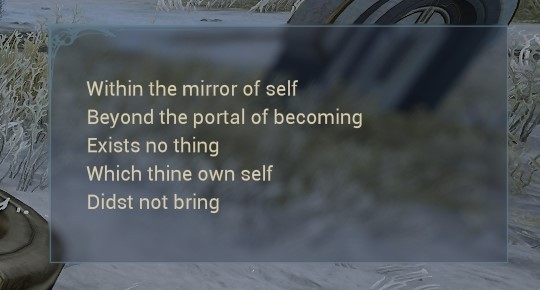
This is text on a giant monument. I see it as a reminder that the Drifter brought everything to Duviri themselves - perhaps blaming both the good and the bad on Drifter.
9 notes
·
View notes
Note
Yanfei: -and then I had to do another suit after that! Honestly, I don't know how you sit through those and listen to them. It's enough to move me to tears, sometimes . . .
Furina: (patting her hand comfortingly) I'm sorry to hear that. (sympathetically) And to tell you the truth, they all start to blend with each other after the first five thousand cases.
Yanfei: (genuinely) That sounds awful, Furina.
Furina: (nodding) It's always the same nasty things that are brought out in a person, like jealousy, anger, and disgust. Especially when there are others involved. It doesn't get as easier to hear as it does old and disappointing.
Yanfei: I really do hate civil court sometimes . . .
Furina: (hums in agreement) Well, let's not dwell on this depressing drabble any longer. (snaps fingers) Some tea, if you please! And get my personal books, too. (to Yanfei) I'd like to hear your thoughts on some of the rulings made on conservation and why turtles aren't allowed in certain public buildings anymore . . .
Well hell, I'm starting to see the appeal too. Give me some of this dynamic a bit more, why don't you?
That ship would work amazingly in that Qixing!Yanfei AU I played around with earlier this year.
Furina constantly inventing cases complicated enough to require Yanfei's involvement, then inviting her over for long, long tea parties afterwards.
Yanfei explaining to Ping, Ganyu, etc., that it's just a professional rivalry!, why are you all reading so much into it?, then fumbling with her codex and a weathered old photo of Furina falls out.
Ten generations of Tianquans reading over their predecessors' notes and unanimously agreeing: "Focalors has a crush, but uh, none of my business."
The Steambird has been digging for dirt on Yanfei for nearly 200 years now.
#furinafei#furina#yanfei#silly headcanons#genshin impact#asks#narcoticwriter#furina even has a matching ahoge!#(as does this version of Yanfei)
34 notes
·
View notes